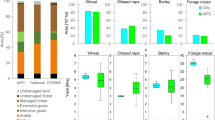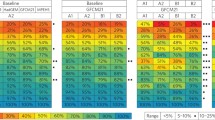Abstract
Understanding cross-sectoral impacts is important in developing appropriate adaptation strategies to climate change, since such insight builds the capacity of decision-makers to understand the full extent of climate change vulnerability, rather than viewing single sectors in isolation. A regional integrated assessment model that captures interactions between six sectors (agriculture, forests, biodiversity, water, coasts and urban) was used to investigate impacts resulting from a wide range of climate and socio-economic scenarios. Results show that Europe will be significantly influenced by these possible future changes with between 79 and 91 % of indicator-scenario combinations found to be statistically significantly different from the baseline. Urban development increases in most scenarios across Europe due to increases in population and sometimes GDP. This has an indirect influence on the number of people affected by a 1 in 100 year flood which increases in western and northern Europe. Changes in other land uses (intensive farming, extensive farming, forests and unmanaged land) vary depending on the scenario, but food production generally increases across Europe at the expense of forest area and unmanaged land to satisfy increasing food demand. Biodiversity vulnerability and water exploitation both increase in southern and Eastern Europe due to direct effects from climate and indirect effects from changes in land use and irrigation water use. The results highlight the importance of considering non-climatic pressures and cross-sectoral interactions to fully capture climate change impacts at the regional scale.


Similar content being viewed by others
Notes
CLimate change Integrated Methodology for cross-Sectoral Adaptation and Vulnerability in Europe
References
Alcamo J, Flörke M, Märker M (2007) Future long-term changes in global water resources driven by socio-economic and climatic changes. Hydrol Sci J 52:247–275
Audsley E, Trnka M, Sabaté S, Sanchez A (2014) Interactive modelling of land profitability to estimate European agricultural and forest land use under future scenarios of climate, socio-economics and adaptation. Clim Chang. doi:10.1007/s10584-014-1164-6
Barthel R, Reichenau TG, Krimly T et al (2012) Integrated modeling of global change impacts on agriculture and groundwater resources. Water Resour Manag 26:1929–1951
Baruffi F, Cisotto A, Cimolino A et al (2012) Climate change impact assessment on Veneto and Friuli plain groundwater. Part I: an integrated modeling approach for hazard scenario construction. Sci Total Environ 440:154–166
Bergh J, Freeman M, Sigurdsson B et al. (2003) Modelling the short-term effects of climate change on the productivity of selected tree species in Nordic countries. Forest Ecology and Management 183:327–340
Brown C, Brown E, Murray-Rust D et al (2014) Analysing uncertainties in climate change impact assessment across sectors and scenarios. Clim Chang. doi:10.1007/s10584-014-1133-0
Busch G (2006) Future European agricultural landscapes – what can we learn from existing quantitative land use scenario studies? Agric Ecosyst Environ 114:121–140
Carter TR, Jones RN, Lu X et al (2007) New asessment methods and the characterisation of future conditions. In: Parry ML, Canziani OF, Palutikof JP, van der Linden PJ, Hanson CE (eds) Climate change 2007: impacts, adaptation and vulnerability. Cambridge University Press, Cambridge, pp 133–171
Dubrovsky M, Trnka M, Svobodova E, Dunford R, Holman IP (this volume) Developing a reduced-form ensemble of climate change scenarios for Europe and its application to selected impact indicators. Clim Change (under review)
Dunford R, Smith A, Harrison PA, Hanganu D, (2014) Ecosystem service provision in a changing Europe: adapting to the impacts of combined climate and socio-economic change, Landscape Ecology (under review)
Dunford R, Harrison PA, Jager J, Rounsevell MDA, Tinch R (2014b) Exploring climate change vulnerability across sectors and scenarios using indicators of impacts and coping capacity. Clim Chang. doi:10.1007/s10584-014-1162-8
Gramberger M, Zellmer K, Kok K, Metzger M (this volume) Stakeholder Integrated Research (STIR): A new approach tested in climate change adaptation research. Clim Change doi: 10.1007/s10584-014-1225-x
Harrison PA, Berry PM, Henriques C, Holman IP (2008) Impact of socio-economic and climate change scenarios on wetlands: linking water resource and biodiversity meta-models. Clim Chang 90:113–139
Harrison PA, Holman IP, Cojocaru G et al (2013) Combining qualitative and quantitative understanding for exploring cross-sectoral climate change impacts, adaptation and vulnerability in Europe. Reg Environ Chang 13:761–780
Harrison PA, Holman IP, Berry, PM (this volume) Assessing cross-sectoral climate change impacts, vulnerability and adaptation: An Introduction to the CLIMSAVE project. Clim Change (Editorial)
Hertel TW (2011) The global supply and demand for agricultural land in 2050: a perfect storm in the making? Am J Agric Econ 93:259–275
Hibbard KA, Janetos AC (2013) The regional nature of global challenges: a need and strategy for integrated regional modelling. Clim Chang 118:565–577
Holman IP, Rounsevell MDA, Shackley S et al (2005) A regional, multi-sectoral and integrated assessment of the impacts of climate and socio-economic change in the UK: II results. Clim Chang 71:43–73
Holman IP, Rounsevell MDA, Berry PM, Nicholls RJ (2008a) Development and application of participatory integrated assessment software to support local/regional impact and adaptation assessment. Clim Chang 90:1–4
Holman IP, Rounsevell MDA, Cojacaru G et al (2008b) The concepts and development of a participatory regional integrated assessment tool. Clim Chang 90:5–30
Holman I, Cojocaru G, Harrison PA (2013) Guidance report describing the final version of the CLIMSAVE Integrated Assessment Platform. Available from http://www.climsave.eu/climsave/doc/Report_on_the_Final_IA_Platform.pdf, Accessed 29/7/2014
Jäger J, Rounsevell MDA, Harrison PA et al. (this volume) Assessing policy robustness of climate change adaptation measures. Clim Change (under review)
Kebede AS, Dunford R, Mokrech M et al. (this volume) The sensitivity of key European sectors to cross-sectoral impacts of climate and socio-economic drivers. Clim Change (under review)
Keith DA, Akçakaya HR, Thuiller W et al (2008) Predicting extinction risks under climate change: coupling stochastic population models with dynamic bioclimatic habitat models. Biol Lett 4:560–563
Kirshen P, Ruth M, Anderson W (2008) Interdependencies of urban climate change impacts and adaptation strategies: a case study of metropolitan Boston USA. Clim Chang 86:105–122
Kovats S, Valentini R, Bouwer LM et al. (2014) IPCC AR5 Chapter 23, Europe, online resource available at http://ipcc-wg2.gov/AR5/images/uploads/WGIIAR5-Chap23_FGDall.pdf, Accessed 29/7/2014
Lehner B, Döll P, Alcamo J et al (2006) Estimating the impact of global change on flood and drought risks in Europe: a continental, integrated analysis. Clim Chang 75:273–299
Lobell DB, Field CB, Cahill KN, Bonfils C (2006) Impacts of future climate change on California perennial crop yields: Model projections with climate and crop uncertainties. Agricultural and Forest Meteorology 141:208–218
Lorenzoni I, Jordan A, Hulme M et al (2000) A co-evolutionary approach to climate change impact assessment: Part I. Integrating socio-economic and climate change scenarios. Glob Environ Chang: Hum Policy Dimens 10:57–68
Moss RH, Edmonds JA, Hibbard KA et al (2010) The next generation of scenarios for climate change research and assessment. Nature 463:747–756
Nicholls RJ, Tol RS (2006) Impacts and responses to sea-level rise: a global analysis of the SRES scenarios over the twenty-first century. Philos Trans R Soc A Math Phys Eng Sci 364:1073–1095
Rasche L, Fahse L, Bugmann H (2013) Key factors affecting the future provision of tree-based forest ecosystem goods and services. Clim Chang. doi:10.1007/s10584-012-0664-5
Rounsevell MDA, Metzger MJ (2010) Developing qualitative scenario storylines for environmental change assessment. Wiley Interdiscip Rev Clim Chang 1:606–619
Rounsevell MDA, Berry PM, Harrison PA (2006) Future environmental change impacts on rural land use and biodiversity: a synthesis of the ACCELERATES project. Environ Sci Pol 9(2):93–100
Rounsevell MDA, Arneth A, Alexander P et al (2013) Towards decision-based global land use models for improved understanding of the Earth system. Earth Syst Dyn Discus 4:1–51
Soussana JF, Graux AI, Tubiello FN (2010) Improving the use of modelling for projections of climate change impacts on crops and pastures. J Exp Bot 61:2217–2228
van Vuuren DP, Carter TR (2014) Climate and socio-economic scenarios for climate change research and assessment: reconciling the new with the old. Clim Chang 122:415–425
van Vuuren DP, Isaac M, Kundzewicz ZW et al (2011) The use of scenarios as the basis for combined assessment of climate change mitigation and adaptation. Glob Environ Chang 21:575–591
Xiong W, Holman I, Lin E et al (2010) Climate change, water availability and future cereal production in China. Agric Ecosyst Environ 135:58–69
Acknowledgments
The research leading to these results has received funding from the European Commission Seventh Framework Programme under Grant Agreement No. 244031 (The CLIMSAVE Project; Climate change integrated assessment methodology for cross-sectoral adaptation and vulnerability in Europe; www.climsave.eu). CLIMSAVE is an endorsed project of the Global Land Project of the IGBP. The authors would like to thank all CLIMSAVE partners for their contributions to many productive discussions related to the content of this paper.
Author information
Authors and Affiliations
Corresponding author
Additional information
This article is part of a Special Issue on “Regional Integrated Assessment of Cross-sectoral Climate Change Impacts, Adaptation, and Vulnerability” with Guest Editors Paula A. Harrison and Pam M. Berry
Electronic supplementary material
Below is the link to the electronic supplementary material.
ESM 1
(DOCX 1615 kb)
Rights and permissions
About this article
Cite this article
Harrison, P.A., Dunford, R., Savin, C. et al. Cross-sectoral impacts of climate change and socio-economic change for multiple, European land- and water-based sectors. Climatic Change 128, 279–292 (2015). https://doi.org/10.1007/s10584-014-1239-4
Received:
Accepted:
Published:
Issue Date:
DOI: https://doi.org/10.1007/s10584-014-1239-4




